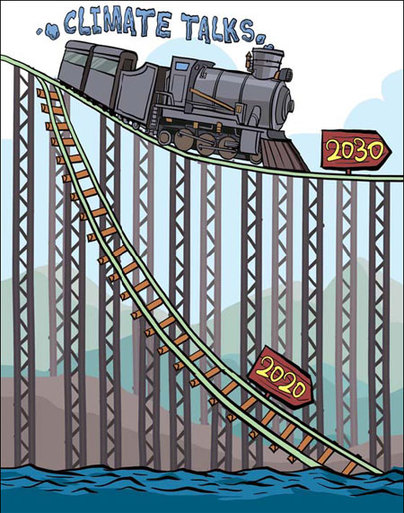A new formula to help save the planet
Updated: 2011-10-28 10:59
By ZhongXiang Zhang (China Daily European Weekly)
|
|||||||||
Putting caps on carbon emissions is well and good, but the target dates set need to be reconsidered
The United Nations climate change conference in Copenhagen almost two years ago ended in great disappointment for many, particularly given that the election campaign pledge of the US President, Barack Obama, "Yes, we can", had raised such high hopes for the meeting.
 |
|
Zhang Chengliang / China Daily |
Still, things could have been a lot worse - negotiations could have collapsed.
Now climate negotiators are working on crucial issues to reach a deal in the next climate change summit to be held in Durban, South Africa, at the end of next month.
But if negotiations continue as at present, they will fail to produce a long-awaited legally binding global agreement, as happened in Copenhagen. This is because of a key flaw in current negotiations: planned commitments are tied to two target dates, 2020 and 2050. The first of these dates leaves little room for maneuver for China and the US, in each case for different reasons.
The Intergovernmental Panel on Climate Change calls for global greenhouse gas emissions to be at least halved by 2050. To achieve that goal the commission's fourth assessment report recommends that global greenhouse gas emissions should peak by 2020 at the latest and then start falling to stave off the risk of dangerous climate change. It calls for developed countries to cut greenhouse gas emissions by 25-40 percent by 2020 relative to 1990 levels.
This recommendation was incorporated into the Bali Roadmap at the UN climate change conference in 2007. It seems logical. Once the long-term goal (the 2050 target) is set, a mid-term goal is needed to help meet the long-term one. Thus, negotiations on industrialized countries' commitments have been on what emissions reduction targets would be in 2020.
But that is just around the corner. More importantly, it poorly accommodates the world's two largest greenhouse gas emitters, China and the US. Because the US withdrew from the Kyoto Protocol, it made no substantial preparations to cut emissions as other Kyoto-constrained industrialized countries have done over the past decade. Like it or not, that is a fact. Developing countries have demanded that the US make substantial emissions cuts by 2020, but that is an exceptionally hard task for an unprepared country to undertake.
In the meantime, China has overtaken the US to become the world's largest emitter of greenhouse gases. That happened in 2007, at least 20 years earlier than had been expected as late as 2004. The International Energy Agency estimates that about half of the growth of global energy-related CO2 emissions until 2030 will come from China. The US, which has a huge trade deficit with China, has pushed for it to take on emissions caps as early as 2020. Otherwise, goods from China to US markets will be subject to carbon tariffs.
But 2020 is an unrealistic date for China to absolutely cap carbon emissions, because they would still be on rising trajectories beyond 2030, even if some energy saving policies and measures have been taken into account in such projections.
As for 2050, that seems too far off for politicians to adopt as a commitment date. If the earlier period was extended to 2030, it would open up the possibility for the US and China to make the commitments that each wants from the other in the same form, although the scale of reductions would differ from one another. By 2030 the US will be able to commit to much deeper emissions cuts that China and other developing countries have demanded, and China would have approached the threshold to take on the absolute emissions cap that the US and other industrialized countries have long asked for.
Obama, aware that his proposed provisional target in 2020 was well below what is internationally expected, announced a provisional target of reductions of 42 percent by 2030 relative to 2005 levels to demonstrate the continuing US commitment and leadership to find a solution to climate change. That target still lacks ambition, but at least Obama is heading in the right direction.
What needs to be reviewed is the target year of 2030. If international negotiations could lead to much deeper emissions cuts for developed countries as well as the absolute emissions caps for major developing countries in 2030, that would significantly reduce the legitimacy of the US proposed carbon tariffs and, if implemented, their prospect for withstanding a challenge before the World Trade Organization.
That will also alleviate concern about when China's greenhouse gas emissions peak and what China is going to do. More importantly, it opens the possibility to cap the carbon emissions of the world's two largest emitters in a legally binding global agreement.
The author is a senior fellow, PhD in economics, at the East-West Center, Honolulu. The opinions expressed in the article do not necessarily reflect those of China Daily.











